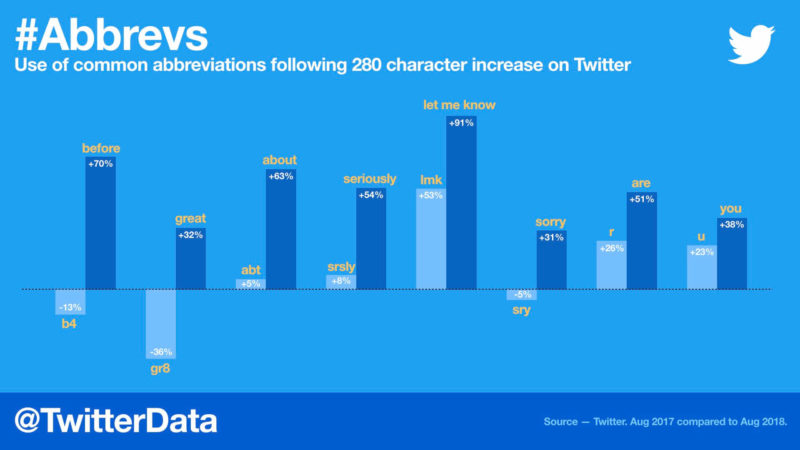Despite 280-character expansion, short Tweets are still the norm
After increasing Tweets to 280 characters a year ago, Twitter says the most common length of a Tweet is still under 35 characters.

Since doubling character limits for Tweets to 280 characters a year ago, Twitter says people are still keeping their Tweets short and replying more often. On Tuesday, the company released a list of trends it has noticed since upping character limits. After analyzing how Tweets have changed since character limits doubled, here’s what Twitter learned.
Tweets are shorter. Twitter says the most common length of a Tweet now is 33 characters, and that only three percent of global Tweets are over 190 characters. Only one percent of English Tweets reach the 280-character limit.
Not only have Tweets remained brief, but Twitter says more people are using “please” and “thank you” in their messaging. The company says there has been a 54 percent increase in the use of the word “please” and a 22 percent increase for “thank you” since doubling character limits.
(Whether or not people are actually nicer on the platform is up for debate. The amount of abusive content is still an issue for Twitter — so much so that it has been the company’s primary focus ahead of the U.S. November elections.)
Fewer abbreviations, but more questions. The company says fewer people are using abbreviations for words like great, before and sorry. Since doubling the character limit, the frequency of the abbreviation “gr8” is down 36 percent, “b4” is down 13 percent, and “sry” is down 5 percent. Meanwhile, the full-spelling of those words are on the rise, with “great” up 32 percent, “before” up 70 percent and “sorry” up 31 percent.
Twitter says it has seen a 30 percent increase in the number of Tweets that include a question mark “?” — which, arguably, is more of a statement on current times than the number of questions being posed.
More engagement. Overall, Tweets are receiving more replies, but Twitter didn’t disclose any specific metrics around how many more replies are happening. Still, since replies are up it could mean there is more conversation happening on the platform — and a greater likelihood that brands could be generating more engagement.
The sweet spot for a Tweet’s length appears not to have changed since Twitter gave users more characters. At the previous 140-character limit, Twitter says the most common length was 34 characters. At the current 280 character limit, the most common Tweet length is one-character shorter at 33 characters.
Twitter says when tweets could only be 140 characters, less than 10 percent (9 percent) hit the character limit. Now that the character limit is double that, only one percent of English Tweets are making use of all 280 characters and 12 percent are longer than 140 characters. Five percent of English Tweets are longer than 190 characters.
Contributing authors are invited to create content for MarTech and are chosen for their expertise and contribution to the search community. Our contributors work under the oversight of the editorial staff and contributions are checked for quality and relevance to our readers. MarTech is owned by Semrush. Contributor was not asked to make any direct or indirect mentions of Semrush. The opinions they express are their own.
Related stories
New on MarTech